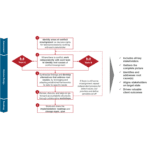
Not everyone enjoys change. In fact, most people do not. There is a variety of psychological, social, environmental, and cultural reasons why people don’t enjoy change, but that’s a moot point – organizations often need to change. Thus, they must be able to manage the fact that people resist change.
To this end, here are six best-practice guidelines that organizations can follow for effective change management.
6 Best-practices for successful change management
-
Change only what’s needed
Change is important to organizations – it ensures they stay current, continue employing best practices, seize opportunities when they present themselves, and succeed in the competitive landscape. However, one of the most effective ways of managing the change process is by regulating the pace of change, – changing only what’s required to succeed.
While this might seem counterintuitive and beyond the control of the individuals setting out to manage the change process, it rings true if you consider the underlying message behind this statement.
For example, when you have multiple organizations or departments merging into one and the buy-in of staff and affected stakeholders is essential (as it always is), it is important to minimize how much is happening at any point in time. By setting the change hurdle as low as possible, people are less likely to retreat from the process. The goal is to get people to opt-in and get on-board. If that means that change must come in stages – so be it; it’s worth it for a successful transition. Further optimization and changes are always possible in the future, but it won’t happen if the process falls apart from the get-go because the organization pushed change too hard, too soon.
-
Communicate clearly and consistently
The more an organization can clearly and consistently communicate to provide certainty, the better, both for staff and for the organization itself.
An important part of change management is ensuring there is a clear, defined target state to progress towards, and a reason for the change (the ‘change story’). This understanding of where you want to get and why you want to get there is essential not only so management and the organization can understand why they should proceed and what benefits are to be gained, but also to provide a pathway for the change. Without this, change can be haphazard, and potential gains can go unrealized due to poor execution.
The change story feeds into effective communications that are crucial to an organization’s people and stakeholders. It is important to help people understand why they are being pushed away from their usual way of working into uncertainty. By allowing people to understand the reasoning behind a change and how it will impact them, the organization helps to limit the resistance to change that stems from fear of the unknown.
People are more likely to be at ease and less likely to resist the process when they are up-to-date and aware of what is happening and why it is changing. Buy-in from people is crucial; as such, organizations should make every effort to maximize effective communication, ensuring its people are comfortable throughout the process.
-
Consistent leadership support
The support and buy-in from all levels of leadership are as crucial as the support and buy-in of staff.
While vigorous debate amongst leadership during the planning and execution process is important to ensure the change story is worth pursuing and the process is properly planned, this debate should not spill out into communications with the organization’s wider people. Messaging and conversations with staff should present a clear, consistent, unified front. Inconsistencies lead to uncertainty and hesitation, undermining the belief in the benefits change will bring and undercutting the whole process.
-
Have a single source of the truth
To support the consistent communication called for above, an organization should use a guide, handbook or intranet page that people can look to as the one source of truth during this process.
During significant periods of change, rumors tend to abound. As such, it is essential to make sure people can come back to one ‘set in stone’ bible that folds in all important information regarding the change, including the change story, and provides answers to many – if not all – the questions people may have. A source of truth also provides consistent messaging to staff – hopefully minimizing instances of facts being lost in translation and different people being told slightly different things, all of which can negatively affect the change process.
-
Timelines must be public and consistently met
Speaking of set in stone, a public timeline is a crucial element of any change. It is important to publish and communicate timelines to ensure accountability and to keep the process moving to a set schedule.
An additional benefit is providing a measure of comfort and reassurance to staff. During periods of change, people naturally feel uncomfortable and unsettled. Consistently meeting published timelines fosters a level of certainty and trust. When people are waiting for information to come out, and decisions to be announced that affect their jobs and how they work every day, the last thing they need is to be kept waiting longer than expected. Many things can be rescheduled, but a published timeline should not be one of them. Every effort needs to be focused on treating staff with respect and treating the timeline as an unmovable deadline.
-
Utilize change champions
Change Champions are crucial in helping to manage morale, as well as minimizing hesitation and reticence. Change Champions generally comprise volunteer staff members chosen from a variety of levels who wish to take a more active role in the change process. Regular briefings should be provided to update Change Champions on the status of the organizational change as it progresses. This allows Change Champions to assist with maintaining positive vibes amongst staff in relation to the change process, and can enable them to be a valuable information resource for concerned staff members, separate from direct managers and other leadership, who have questions or desire more information. It helps to have a colleague to talk to sometimes, as opposed to having to speak to your manager.
In return for their efforts, Change Champions have access to ‘inside’ information around the change process and progress – something that entices many to volunteer for the symbiotic role. Further, it brings more people into the change process, allowing them to share their views and shape the end-result, making it more collaborative and allowing people to feel more ‘ownership.’* This leads to more acceptance and support for the change – not just from the Change Champions but from the wider staff whose colleagues are seen to be deeply involved and looking out for their interests.
*Collaboration, and the sense of ownership it brings to participants, is a further important part of change management. Other methods can include surveys and interactive townhalls that allow staff to provide input into the process, as well as competitions to decide minor aspects of the end result.
Why effective people management is crucial for successful change management
Successful change management hinges on good people management. An organization is nothing without its people. As we all know, “culture trumps strategy”, and what is culture if not the people of an organization and a set of norms and practices established across these people. If a transformation, unification, merger, divestment, global pandemic-caused change is to succeed, people need to be valued and managed appropriately. By following the above guidelines, change can be managed successfully, and lead to further organizational success.
Our people & organization insights
Find out how we can support your organization's change initiatives.
CONTACT US




